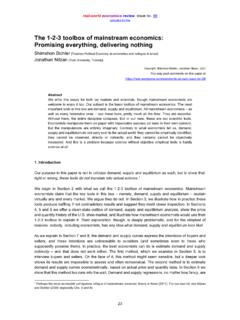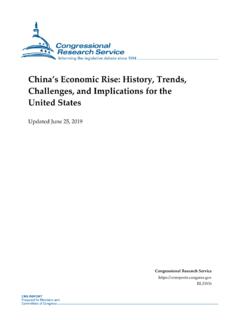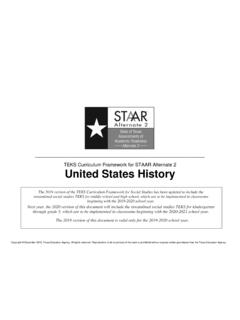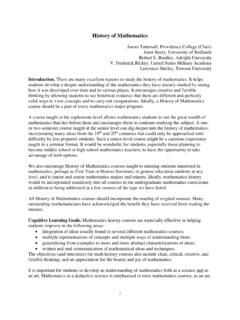Transcription of A brief history of Pakistan’s economic development
1 Real-world economics review, issue no. 80. subscribe for free A brief history of pakistan 's economic development Muhammad Iqbal Anjum and Pasquale Michael Sgro [International Islamic University Islamabad, pakistan ; Deakin University Australia, Australia]. Copyright: Muhammad Iqbal Anjum and Pasquale Michael Sgro, 2017. You may post comments on this paper at Introduction This paper briefly describes the development of pakistan 's economy during seven distinct decades, from the late 1940s to the end of the 2000s. pakistan has progressed from a low- income to a lower middle-income developing economy GDP per capita increased from US$294 in 1980 to US$1,017 in 2010 according to the World Bank (2012). The late 1940s: era of emergence of a new national economy At its inception in 1947, pakistan had a predominantly agrarian economy agriculture contributed 53% of GDP in 1947, and of GDP in Then, pakistan had a population of 30 million with 6 million people living in urban areas, 65% of the labour force working in the agricultural sector, and agricultural output contributing of exports and about 90% of pakistan 's foreign exchange pakistan 's resources, in East pakistan and West pakistan , were an immense reservoir of land and mineral resources natural gas, crude oil, coal, limestone, and pakistan had a per capita income of almost $360.
2 (1985 international dollars) in 19504 and a literacy rate of 10%,5 amidst economic crises . absence of economic infrastructure, financial resources, and industrial Then, poverty incidence ranged from at least 55% to 60% in the West Keeping in view the scarcity of capital in pakistan 's small private sector, the Government relied on the public sector for building the economic -cum-industrial In 1949-50, pakistan registered a national savings rate of 2%, foreign savings rate of 2%, and an investment rate of 4%.9 Then, manufacturing contributed of GDP and the services/trade/other sectors contributed 39%. of GDP a result of policy of imports-substituting pakistan 's trade balance of payments was in deficit by 66 million Rupees (Rs) during 1949/50-1950 1.
3 State Bank of pakistan (2010), Husain (1999) and Zaidi (2005). 2. Husain (1999), Khan (2002), Fasih-Uddin and Swati (2009), and Zaidi (2005). 3. Fasih-Uddin and Swati (2009). 4. Khan (2002). 5. Fasih-Uddin and Swati (2009), and Zaidi (2005). 6. There were small industries and few services, and there were almost no large-scale industrial units at all in 1947 [Husain (1999), Fasih-Uddin and Swati (2009), Zaidi (2005) and The World Bank (Undated)]. 7. Hasan (1997) and Hasan (2004, p. 63). 8. Fasih-Uddin and Swati (2009), and Zaidi (2005). 9. Hasan (1997). 10. Hussain (2003), Husain (1999), and Hasan (1997). 11. Zaidi (2005). 171. real-world economics review, issue no. 80. subscribe for free The 1950s: era of a traditional economy in transition The 1950s was the first decade of After launching the Colombo Plan in 1951, pakistan instituted a series of Five-Year Plans during the period 1955-1998 and a Ten-Year Perspective Plan alongside a rolling Three-Year development pakistan continued its policy of imports-substituting industrialization during the During the Korean War (1950-1953)
4 , pakistan 's public and nascent private sector thrived on spectacular merchant profits, which were transformed into industrial capital that accelerated pakistan banned the imports of cotton textiles and luxury goods in 1952 and regulated virtually all imports in Consequently, pakistan joined the group of the most rapidly growing countries in the But, anti-agriculture policy biases and anti-agriculture terms of trade between industry and agriculture caused the annual growth rate of agriculture to decline from in 1949/50-1950/51 to in 1957/58-1958 After achieving self- sufficiency in cotton textiles in the late 1950s, export development assumed vital significance,19 amidst inflow of the US military and economic aid of US$500 million during Consequently, pakistan entered a phase of foreign aid-dependent growth in the In 1959 after military coup d' tat in 1958, the martial law regime introduced export bonus vouchers, which were treated as import licenses, and free list of the goods, which could be imported without having any import Balance of trade deteriorated from - 831 million Rupees in 1950/51 to -1043 million Rupees in 1959/60 due to sharp decrease in exports from 1,038 million Rupees in 1950/51 to 763 million Rupees in 1959 Agriculture grew at a rate of per annum and manufacturing grew at a rate of per annum in the In 1959-60.
5 Per Capita GNP was in West pakistan and in East The 1960s: era of economic growth Amidst massive inflow of American aid, political stability enabled pakistan to sustain high rates of growth in the Poverty incidence (poverty headcount ratio expressed as a percentage of population) ranged from almost 50% in the early 1960s to 54% in In the 1960s, pakistan achieved an agricultural growth rate of 5% per annum by achieving 12. Zaidi (2005), Khan (2002), and Hasan (1997). 13. Fasih-Uddin and Swati (2009). 14. Hasan (1997), Husain (1999), and Zaidi (2005). 15. Merchant profits referred to the profits realized from the Korean War-induced dramatic growth in exports of raw materials to the war-panicked countries, which were then piling up raw materials during the war [Zaidi (2005), Papanek (1996), and Hussain (2003)].
6 16. Hasan (1997), Khan (2002), and Zaidi (2005). 17. Zaidi (2005) and Husain (1999). 18. Even negative growth rates in the agricultural sector were observed that is, in 1950/51- 1951/52 and in 1953/54-1954/55. With the then 75% of the population of pakistan living in the rural area, the prolonged stagnation of the agricultural sector in the 1950s restricted further growth in the manufacturing sector (Zaidi, 2005). 19. Hasan (1997). 20. This US aid a result of pakistan -United States Mutual Defense Pact signed in 1954 reduced the heavy burden of public expenditure on the budget of the public sector (Hasan, 1997). 21. Nafziger (2012) and Hussain (2003). 22. [Hasan (1997) and Zaidi (2005). 23. Hasan (1997), Zaidi (2005) and Fasih-Uddin and Swati (2009).]
7 24. Fasih-Uddin and Swati (2009). 25. Thus, the West-East Disparity Ratio was (Zaidi, 2005). 26. Chenery and Strout (1966), Papanek (1996). Zaidi (2005) and Khan (2002). 27. Hasan (1997) and Hasan (2004, p. 63). 172. real-world economics review, issue no. 80. subscribe for free significant investments in water resources, increased incentives for farmers, mechanization of agricultural production processes, increased usage of fertilizers and pesticides, and the increased cultivation of high yielding varieties of rice and The large-scale manufacturing grew at a rate of 16% per annum during 1960/61-1964/65 due to protection of domestic industry from imports and subsidies for In the wake of the pakistan - India War of 1965, the reduced foreign economic assistance caused the large-scale manufacturing to grow at a lower rate of 10% per annum during pakistan achieved an average annual growth rate of in GDP during In 1969-70.
8 Poverty incidence declined to 46%32 and Per Capita GNP was in West pakistan and in East pakistan indicating a widening of the regional economic disparity noted earlier. The 1970s: era of socialism and its aftermath Because of growing interregional economic disparity, East pakistan revolted against West pakistan and became independent (Bangladesh) in 1971. Then, the martial law authorities empowered the socialist pakistan People's Party amidst very difficult macroeconomic circumstances33 poverty incidence rose to 55% in 1971-72,34 there was an increase in pakistan 's import bill due to the October 1973 world oil price shock, a serious post-1973. global recession during 1974-77, failures of cotton crops in 1974-75, pest attacks on crops, and massive floods in 1973, 1974, and pakistan experienced the worst inflation during 1972-77, when prices increased by 15% per During 1973-77, annual average fiscal deficit/GDP ratio was Trade balance deficits were US$337 million in 1970-71.
9 And US$1,184 million in A military coup d' tat occurred on 5 July 1977, and the martial law regime accomplished denationalization, deregulation, and Agriculture grew at a rate of per annum and the large-scale manufacturing grew at a rate of per annum in the While the large and medium-scale private manufacturing contributed 75% of the value-added and 70-80% of the total investment in manufacturing in the 1970s, the remainder of the 25% of the value-added was contributed by the small-scale 28. Husain (1999) and Hasan (1997). 29. Hasan (1997). 30. Hasan (1997). 31. Hasan (1997), Zaidi (2005), and Fasih-Uddin and Swati (2009). 32. Hasan (1997). 33. Socialism was instituted by nationalizing private industries/banks/schools/colleges and enforcing socialist reforms in the land tenure system [Husain (1999), Zaidi (2005) and Hasan (1997)].
10 34. Hasan (1997). 35. Hasan (1997) and Zaidi (2005). 36. Hasan (1997). 37. High fiscal deficits were financed primarily by means of inflationary money creation in the 1970s. 38. Zaidi (2005). 39. Due to a significant decline in the popularity of the ruling socialist party caused by both the high inflation and the nationalization policy, the ruling socialist party won the general elections of 1977 with simple majority, amidst the opposition's accusations that the general elections were rigged. Then, the opposition launched an anti-socialist regime political movement, which culminated in pakistan 's second military coup d' tat. The martial law regime launched a program of accelerating economic growth via a massive inflow of the foreign remittances and the foreign aid from the Western countries in the wake of Soviet invasion of Afghanistan in 1979 [(Zaidi, 2005), (Lansford, 2012)].
















